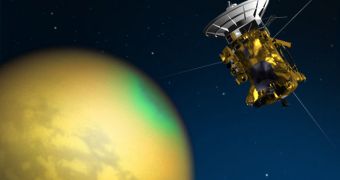Scientists at the NASA Jet Propulsion Laboratory (JPL) in Pasadena, California, announce that the American space agency's Cassini space probe will carry out a new flyby of Titan, Saturn's largest and most interesting moon. The spacecraft will find itself at the point of closest approach to the cosmic body Saturday, June 5 GMT (Friday, June 4 PST), when it passes just 2,000 kilometers (1,300 miles) above the surface. Its instruments will be focused on the moon's northern regions, which currently exhibit the largest concentration of lakes.
These landscape features have fascinated astronomers, astrobiologists and planetary scientists ever since they were first discovered a few years ago. Experts believe that they contain liquid hydrocarbons such as methane and ethane. Cassini has been constructing maps of the north and south poles over the nearly 70 flybys it carried out around the moon, but a large amount of data still remains to be collected, JPL experts say. They manage the mission for NASA's Science Mission Directorate, at the agency's Headquarters, in Washington DC.
“Cassini will make infrared scans of the north polar region, which was in darkness for the first several years of Cassini's tour around the Saturn system. The lighting has improved as northern spring has started to dawn over the area. The visual and infrared spectrometer will be prime during closest approach, but the imaging science subsystem cameras will also be taking pictures. Among the scientific bounties, Cassini team members are hoping to get another good look at Kraken Mare, the largest lake on Titan, which covers a greater area than the Caspian Sea on Earth,” the team says in a press release.
Because of the hazy atmosphere surrounding Titan, snapping photos in visible light wavelengths is impossible. Cassini therefore needs to use its radars for the job, as radio wavelengths can easily pierce the thick layer of clouds covering the areas of interest. The new flyby is budded T69, but it's actually the 70th the space probe conducts around the Saturnine moon. The difference is caused by orbital corrections that were applied early on in the mission, when Cassini had just arrived at the gas giant. Orbital insertion was achieved on July 1, 2004, and the spacecraft has been sending high-quality data of Saturn, its rings and its moons ever since.

 14 DAY TRIAL //
14 DAY TRIAL //